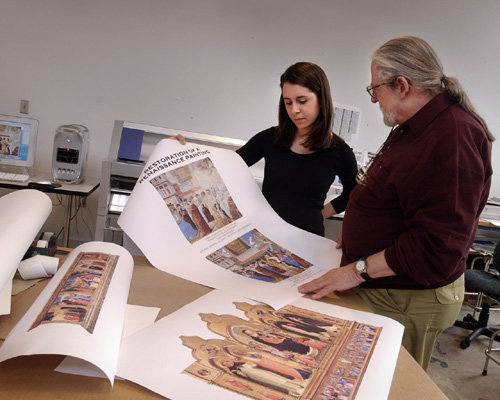Imagine taking centuries-old paintings that have been partially destroyed — or even cut apart and scattered to different parts of the globe — and reconstructing them digitally to reveal their original glory.
It’s being done at Lafayette with fascinating results by students in a course taught by Lew Minter, media lab director at the Williams Visual Arts Building. He and his collaborator on the digital reconstruction method, Diane Cole Ahl, Rothkopf Professor of Art History, will explain it in a presentation noon Thursday in Skillman Library room 3. Lunch will be provided.
In an interim session course, Visual Communication through Technology, students find an image of a Renaissance or medieval painting that has been partially destroyed, do careful research to determine what the missing parts of the painting probably looked like, and create a seamless, digitally reconstructed image of the painting. (Examples of this work are available on Lafayette’s web site.)
“Art history books usually just show how things are in their current state, but we get to see what the original work may well have looked like, in a real hands-on way,” says Alexis Siemons ’05 (Moorestown, N.J.), noting that the process increased not only her appreciation for Renaissance art, but also for the way technology can be used to benefit traditional art.
Siemons, who is pursuing an individualized, interdisciplinary major in English, art and sociology, called communications and culture, explains that much research was needed even to determine which artist’s work to reconstruct. “I needed to look specifically for a painting that had a section missing and the work needs to be done by a well-known enough Renaissance artist that I can find other works by him so I can get a sense both visually and historically of his work.”
“Lew approaches this as us working with him as a team instead of traditional teacher and students,” Siemons adds. “There was no competition [among the students] — it was more like working together on individual projects. Part of our grade was critiquing the other student works as well — learning the terminology and developing the critical eye.”
Minter decided to include this project in his course after digitally reconstructing several early Renaissance paintings in collaboration with Ahl. Most recently, Minter has digitally reconstructed several pieces for Ahl’s upcoming book on Florentine painter and Dominican friar Fra Angelico.
One of the most striking images Minter reconstructed for Ahl’s Fra Angelico book is a predella (the long horizontal structure at the base of an altarpiece) that had been cut apart centuries ago and is now in five panels. Ahl obtained images of the panels, now housed in five separate museums and private collections in Italy and the United States. Using Ahl’s research and expertise and Adobe Photoshop’s creative possibilities, Minter scaled and scanned the images, consolidated the panels, recreated the frame, and adjusted the color to erase the accumulation of centuries of dirt and candle smoke. The resulting image is one that has not been seen for hundreds of years.
“This is an innovative and important use of digital technology to enhance our knowledge of the past, and Lew is the consummate master of this technique,” says Ahl. “Without touching the work itself, we can bring the work closer to what the original beholder saw.”
Ahl relays this story of one of the first digital reconstructions she and Minter completed: “To celebrate the Italian translation of my Benozzo Gozzoli book, my publisher invited me to give a lecture in a church in the town of Montefalco, where Benozzo’s earliest works — including the fresco that Lew and I ‘reconstructed’ — are located. Montefalco is in central Italy, but people came from as far south as Rome and as far north as Milan. The church was packed. When I projected the slide of the reconstructed work alongside one of the original fresco (half of which was destroyed in later renovations), the exclamations of awe and applause literally stopped the talk. When I finished my lecture, the mayor of the town was first to speak. ‘Benozzo’s fresco was lost, but you have given it back to us.'”
“It’s a wonderful opportunity for a marriage of the history of art and digital technology,” adds Ahl.
An award-winning designer, Minter has mounted five solo shows of his paintings and sculpture and participated in a dozen group exhibitions. His work is included in the collection of the Museum of Modern Art in Rome and dozens of private and corporate collections.
Ahl is the author of Benozzo Gozzoli, which shared the Otto Gründler Prize for Best Book in Medieval Studies, awarded at the International Congress on Medieval Studies in 1998. She is editor of Leonardo da Vinci’sSforza Monument Horse: The Art and the Engineering; editor of The Cambridge Companion to Masaccio (Cambridge University Press, 2002), essays on the influential Florentine painter of the early Renaissance; and coeditor of Confraternities and the Visual Arts in Renaissance Italy: Ritual, Spectacle, Image. She is authoring a major book on 15th-century painting for Yale University Press and a book on Fra Angelico for Phaidon Press.

Alexis Siemons ’05 worked on digitally reconstructing Renaissance works of art under the guidance of Lew Minter, director of the art department’s media lab.
